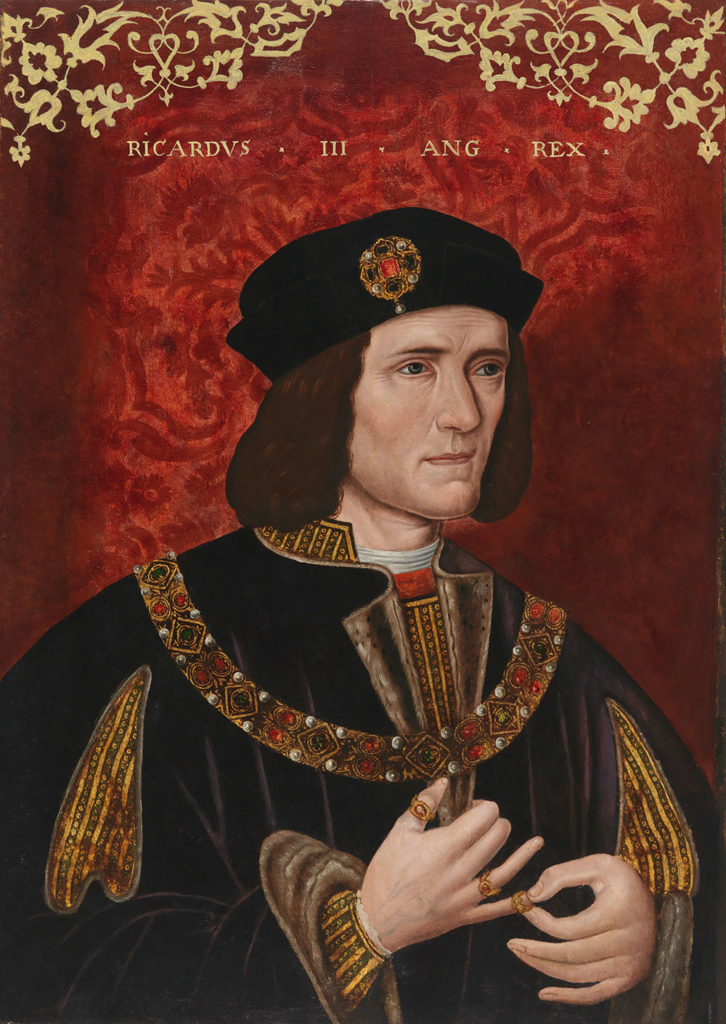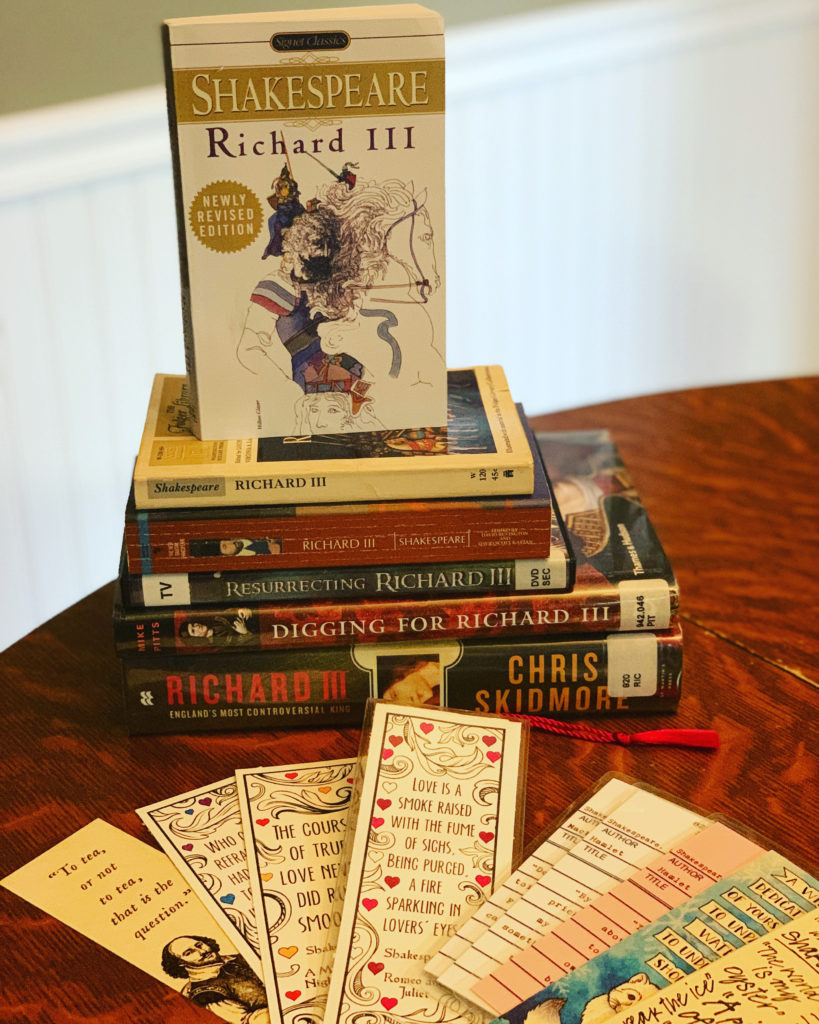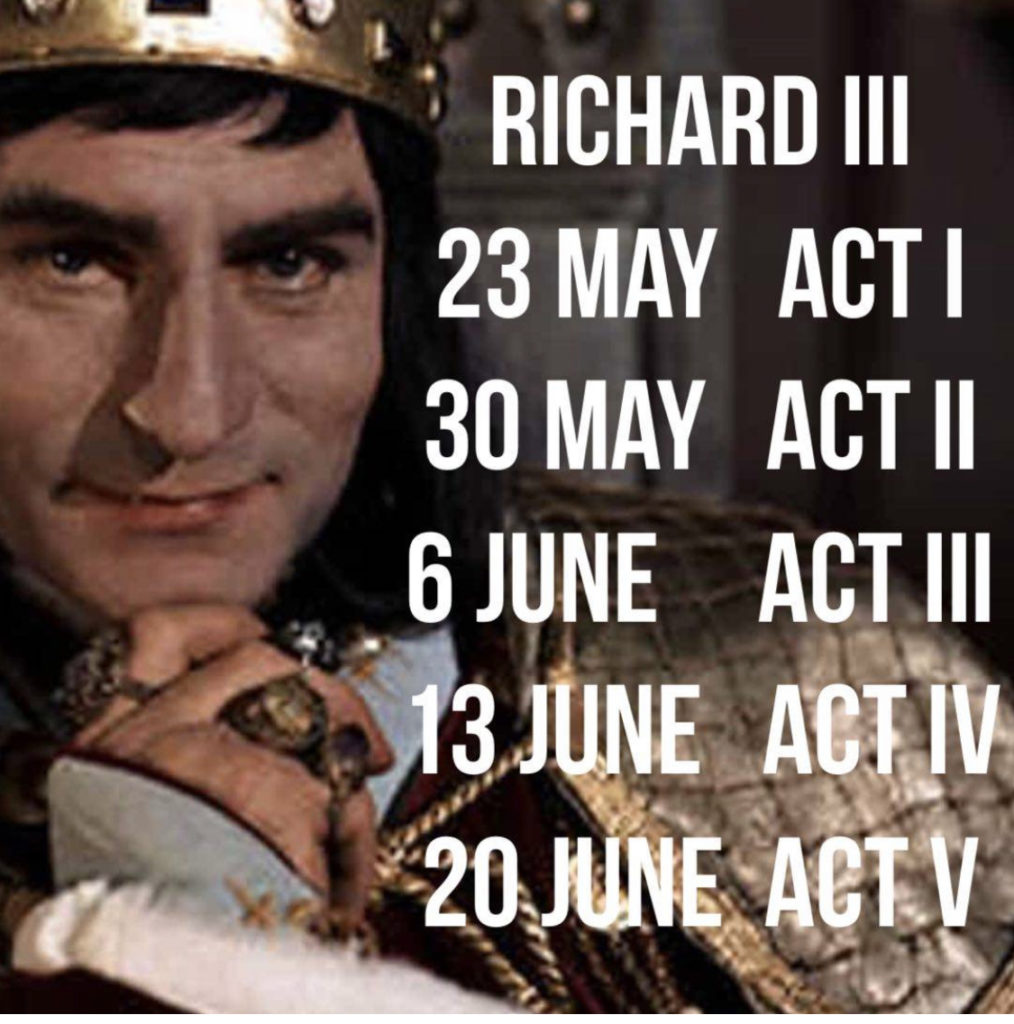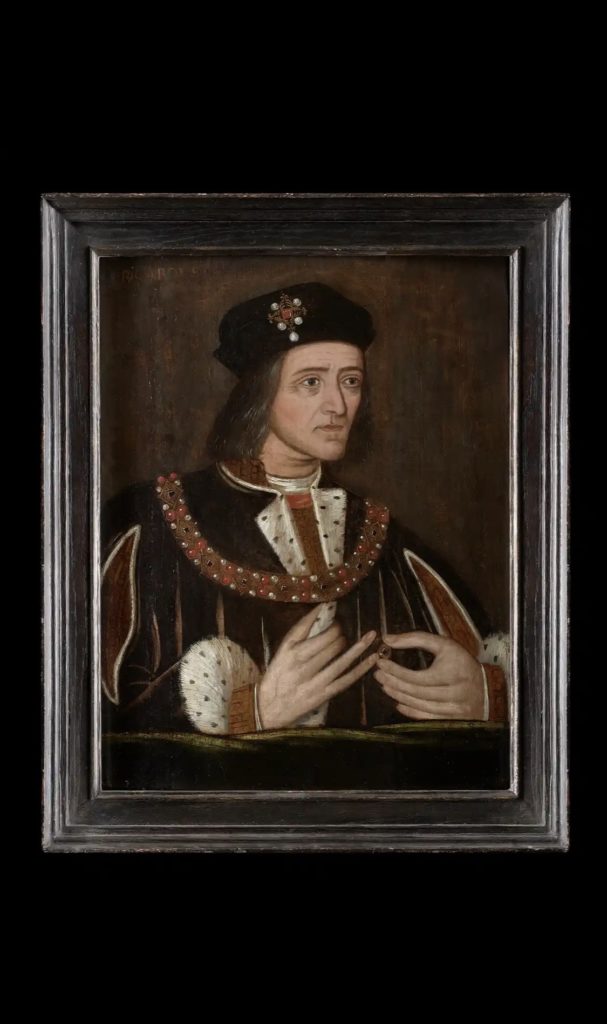
This portrait, in which he appears to be placing a ring on the little finger of his right hand, has been seen by some as evidence of his cruel nature and by others as evidence of his humanity.
This is a particularly fine example of a standard portrait of Richard III of which other versions exist and which may have been copied from an original lost portrait of the king made during his lifetime. It was painted in oils on oak panel in the late sixteenth century; tree-ring dating analysis of the panel support (dendrochronology) has revealed that the wood came from a tree that was felled after 1577. Wood from the same tree has been identified in a portrait of Henry VI in the collection of the Leathersellers’ Company, London, indicating that this painting was probably created as part of a set of royal portraits.
Richard’s posthumous reputation was shaped by the Tudors, first through Sir Thomas More’s ‘History of King Richard III’ and then by William Shakespeare’s iconic characterisation of the king as a devious ruler who was adept at manipulating human weakness in his quest for power. Many scholars and supporters have subsequently tried to rehabilitate Richard’s reputation, including the
author Josephine Tey. In her popular detective novel ‘The Daughter of Time’, her character Inspector Alan Grant’s conviction of the king’s innocence of the murders of the princes in the tower is sparked by his interpretation of Richard’s character from this portrait.
All the known paintings of Richard were completed after his death. One of the earliest portraits, dating from around 1510 may represent the closest likeness of what Richard looked like in life, survives in the Society of Antiquities. Geneticist Turi King, who extracted DNA from Richard’s skeleton, was able to determine that Richard had a high probability of blue eyes and, at least
in childhood, blond hair.
A portrait of Richard III, designed to make him look “odd”, is to go on show in the city where his bones were found.
It is part of the National Portrait Gallery’s Coming Home programme which takes portraits to places with which they are linked.
The monarch’s skeleton was found by archaeologists beneath a Leicester car park in 2012.
Experts say the painting, hosted by the city’s New Walk Museum, was subtle propaganda to undermine his character.
Richard was the last king from the house of Plantagenet and died fighting Henry Tudor, the future Henry VII, at Bosworth in 1485.
The painting – which measures 25ins (64cm) by 18ins (46cm) – is known as the red portrait.

Shakespeare Read A Long

Richard III is a play by William Shakespeare. It was probably written c. 1592–1594. It is labelled a history in the First Folio, and is usually considered one, but it is sometimes called a tragedy, as in the quarto edition. Richard III concludes Shakespeare’s first tetralogy (also containing Henry VI, Part 1, and Henry VI, Part 2, and Henry VI, Part 3) and depicts the Machiavellian rise to power and subsequent short reign of King Richard III of England.
Richard III (2 October 1452 – 22 August 1485) was King of England and Lord of Ireland from 1483 until his death in 1485. He was the last king of the House of York and the last of the Plantagenet dynasty. His defeat and death at the Battle of Bosworth Field, the last decisive battle of the Wars of the Roses, marked the end of the Middle Ages in England.
In August 2012 a team of archaeologists from the University of Leicester unearthed the remains of Richard III, king of England between 1483 and his death in battle in 1485. As news of this unexpected discovery spread around the world, all headlines revolved around the triumph of modern science in identifying the skeletal remains, and the resolve of those determined individuals who had set out to find them. What became lost in the clamour of media attention however, was the story of the grave itself, where the king had lain for over 500 years. The remains were ultimately reinterred at Leicester Cathedral on 26 March 2015.
Many questions and a lot of history to learn with this play. Having been with Henry VI all of 2021 we now move on to Richard III. Many books and even a dvd to watch to start with and probably more to come!
In the Art news a world-famous portrait of Richard III will go on display at the Yorkshire Museum as part of a new display when it reopens on 9 July.
The late 16th century painting, which has become synonymous with the depiction of the controversial king, is on loan from the National Portrait Gallery, London. I would LOVE to go on a field trip to see it!
Shakespeare. Love.



He was a “murderous thug”, Starkey said on Tuesday as he unveiled a late 16th-century portrait of the king, which goes on public display from Wednesday for the first time.
The portrait has been purchased from a private collection by Hever Castle in Kent to hang in its Long Gallery, filling a gap in its remarkable collection of royal historic portraits.
Starkey is delighted by the purchase, less so by the man, calling attempts to improve Richard III’s reputation “a fascinating example of the English fascination with a loser”.
One of the “funniest events in recent history”, Starkey said, was the reburial ceremony after the discovery of Richard’s body in a car park. “A ludicrous performance complete with Diana-esque scenes of public sobbing and mourning.”
The newly displayed portrait is an example of the only painted portrait of Richard, best known from a 16th-century panel in the collection of the National Portrait Gallery.
A ludicrous performance complete with Diana-esque scenes of public sobbing and mourning’
David Starkey on the reburial ceremony
It shows the king placing a ring on his extraordinarily long little finger, seen by some as evidence of his despicably cruel nature.
Starkey said it was important to put Richard III, who reigned for two years before defeat at the Battle of Bosworth in 1485, in a house devoted to the Tudors and in a gallery – which he has curated – which tells their story.
“Richard III is the real founder of the House of Tudor. If he hadn’t split the House of York we would have never heard of Henry VII. Henry, Earl of Richmond would have been some forgotten exile.”
The newly purchased painting has been in private collections for many years. Duncan Leslie, Hever Castle’s chief executive, said: “I am delighted that we have been able to purchase this painting and further enhance the historical experience we offer. It is an important addition to better tell the story of the Tudors, or rather how they came about.”
Different people will look at the portrait and see different things. Starkey says he looks at it and sees the former prime minister Gordon Brown. “That twitch, that nervous intensity, the fiddling with the hands, the frown.”
The painting goes on display from 2 October, 567 years to the day since Richard III was born.”
published article via
THE GUARDIAN


